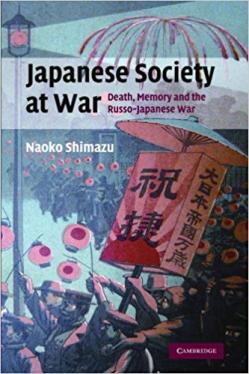Japanese Society at War: Death, Memory and the Russo-Japanese War

Studies in the Social and Cultural History of Modern Warfare (No. 28), Birkbeck College, University of London, 2009, 354 pages, ISBN-13: 9780521859349
Review by Peter Gysin
The Russo-Japanese war, the author reminds us, was hugely symbolic – the first victory for a non-white, non-Christian, emerging nation over a white, Christian, developed counterpart, it inspired nationalist revolutionary movements in Asia and the Russian empire itself. Histories of the war tend to focus on the “big picture,” diplomatic machinations leading to, and concluding, the fighting, and the epic land and sea battles (the scale of the slaughter should have made this, not World War I, the conflict to end romantic notions of warfare). This book examines the smaller, human picture.
Received wisdom ascribes Japan’s victory to a combination of national unity (in contrast to revolutionary racked Russia), proximity to the theatre of war, her strategic alliance with Britain and better planning, but mainly to the spirit of the Japanese soldiers, willing, perhaps even wanting, to die heroically. Such self-sacrifice, reinforced by accounts such as Sakurai Tadayoshi’s Human Bullets (Sakurai bewails the drowning of an officer, not for the fact of death but as a lost opportunity to die in battle) made a huge impression on foes and observers alike. Subsequently, in the Russian Civil war, Bolshevik officers could sometimes only maintain morale by assuring troops that their Japanese foes were Korean; later, Soviet commentators denigrated Japanese soldiers as smertniki (death seekers).
Dr Shimazu paints a more complex picture of Japanese society (military and civilian) than that propounded by contemporary state propaganda or, for that matter, western observers, modifying a number of stereotypes. Japan’s national character was not monolithic – there was a peace movement, her army too had its sceptics, deserters and suicides. Conversely, Russians, less motivated, could also fight to the death.
Russia’s defeated Commander-in-chief Kuropatkin cited the education of Japan’s rank and file (unlike their often illiterate Russian counterparts) as a key factor in her triumph. Many (with official encouragement) kept diaries; conscripts’ vivid accounts of their journeys across Japan before embarkation, and impressions of Manchuria and Korea (generally unfavourable) and opponents (grudging respect) form a memorable part of the book. The author shows how the journey from home village to port, seeing famous temples, castles and scenery for the first time, cheered by crowds at stations en route, instilled in the conscripts a sense of patriotic identity – assuaging but not removing anxiety over the fighting to come and the effect on their dependents should they, the breadwinner, perish. Loyalty to the state conflicted with family obligations. To sugar the pill, the state came up with the slogan “honourable war death” – but conscripts did not, “buy” this notion (more appropriate for the samurai class to which they did not belong) even if they could only criticise it obliquely.
Similarly jaundiced could be the reactions of those who had experienced fighting to the patriotic fervour of the domestic public, who often treated the war as an excuse to party. But gatherings mean crowds and even patriotic crowds can and did get out of hand – with sometimes fatal results. If the Japanese authorities struggled to dampen patriotic fervour – undignified in a nation seeking to portray itself as civilised – they were scarcely less able to hold back the peace activists. We learn that (surprisingly) anti-war journals, along with poems and works of art on the futility of war death, continued to be produced throughout the conflict.
Another particularly memorable chapter covers Russian POWs’ time in Matsuyama, whose generous treatment (recreational facilities, freedom of movement, cultural sensitivity towards non-Russian minorities), to the bafflement of Japanese diehards but the benefit of the local economy, seems more like a holiday camp. WW II veterans of Japanese incarceration will raise an eye brow on reading of Russian complaints over the food. Of course there were diplomatic imperatives behind what the author terms “humanitarian nationalism”, Japan at pains to display to the outside world behaviour towards the vanquished befitting a civilised nation.
Other chapters describe how the government (anxious to spare the Exchequer) left commemoration of the war dead and succour to bereaved families largely to local elites; the posthumous “deification” of naval officer Hirose – centrally inspired but lasting well beyond the war thanks to popular renderings in song, and on screen and stage; and consciousness of the war in its aftermath – today, seemingly greater in Portsmouth, New Hampshire, the scene of the protracted peace negotiations, whose centenary was celebrated in 2005, than in the combatant countries.
Though manifestly the fruits of scholarship, this readable book is for the layman as well as historian. While it assumes a broad knowledge of the war, it provides enough background for non cognoscenti to fill in the gaps. With 35 evocative photographs and 2 maps, it is rich in detail – from socialising across the front line during a New Year’s Eve truce, to schoolboys misbehaving on outings to see Russian prisoners, soldiers’ preoccupations (women, letters from home, food) and the treatment of the (much fewer) Japanese prisoners in Russia.

